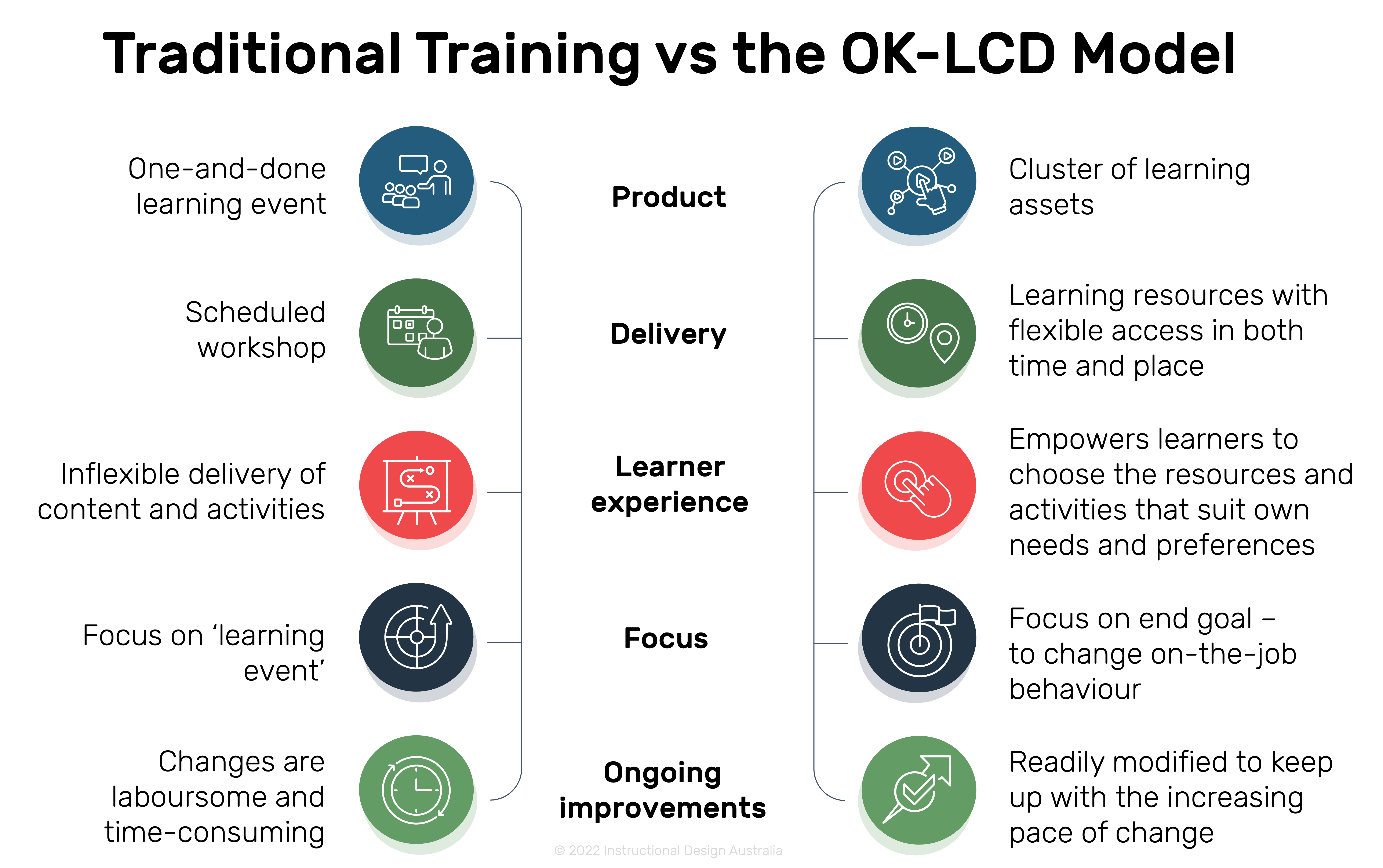Modern Learning and Development: The OK-LCD Model
With technology, learning is at our fingertips – podcasts, how-to videos and blogs are just some of the ways we feed our hunger for learning just about anything! As modern learners, we expect resources to be engaging, set up to enable shared learning, to-the-point and accessible just-in-time.
So, why is it that these preferences are often overlooked when it comes to ‘training’?
Although an abundance of resources may be available, few are assembled in a way that supports change. The ‘classroom’ is still a primary delivery mode, with many programs being inflexible in catering for individual preferences; neglecting to consider how learners will carry learning through to real action on-to-job. IDs often try to close the capability gap with just one learning event – whether it be a face-to-face workshop, virtual training or eLearning – rather than considering blended learning for instructional scaffolding.
Corporate training is often scheduled, rigid and finished as soon as learners leave the classroom.
How can we integrate our digital-age learners’ preferences into training?
Ovens-Kadakia Learning Cluster Design Model (The OK-LCD Model)
Crystal Kadakia and Lisa M.D. Ovens (2020) have designed a new framework for future capability development: the Ovens-Kadakia Learning Cluster Design Model (or OK-LCD for short)[1].
Essentially, the model suggests combining existing resources with newly created resources to form ‘learning clusters’ designed to develop certain capabilities. Learners can access the learning cluster diverse assets and choose the resources and activities that best suit their needs and preferences.
Principles
The OK-LCD Model consists of four principles:
- Go beyond ‘one-and-done’: Create multiple assets for one capability gap.
- Design the whole, not the parts: All assets should be designed as pieces of a puzzle.
- Focus on learner needs: Know your audience – when, where and how they learn – the cluster should support their needs.
- Change on-the-job behaviour: Focus on creating permanent behavioural shifts in the workplace to achieve desired business results.
Actions
Instructional Designers use the five action-focused elements sequentially to create a learning cluster:
- Change on-the-job behaviour: Determine the business results you want to see, and the learning outcomes that will help achieve them.
- Learn learner differences: Personalise learning to accommodate varying needs and preferences.
- Upgrade existing assets: Improve current materials to form the base of the learning cluster.
- Surround learners with meaningful assets: Add to the learning cluster by providing a variety of immediate, social and formal learning resources designed to build specific capabilities.
- Track transformation of everyone’s results: Evaluate effectiveness of learning clusters to measure the impact of learning and identify opportunities for improvement.
Traditional Training vs OK-LCD Model
So, how is the OK-LCD Model different from traditional approaches to learning?
Final thoughts
As learners adapt to both technological and business shifts, so too must L&D. Learning resources should be easy-to-find, immediate, relevant and appealing to learners.
So, how do we do it? The OK-LCD Model is worth considering.
It integrates how we choose to learn outside of the workplace into corporate training. It caters for modern learner needs and preferences. It applies current, evidence-based practices to facilitate capability develop and support business success.
Consider how a learning cluster could be the solution to the learning needs in your next project, then follow the ‘actions’ to bring it to life!
Relevant articles:
- Blended Learning
- Learning Transfer
- What is the ADDIE Model of Instructional Design Anyway?!
- Do You Want to Create an Online Course or eLearning?
- Embedding Activities in Learning Design: Why Leaders Matter
- Peer Learning/Shared Learning
- The 70:20:10 Learning Model
References:
[1] Owens, L., & Kadakia, C. (2020). Designing for modern learning: Beyond ADDIE and SAM. American Society for Training and Development.

